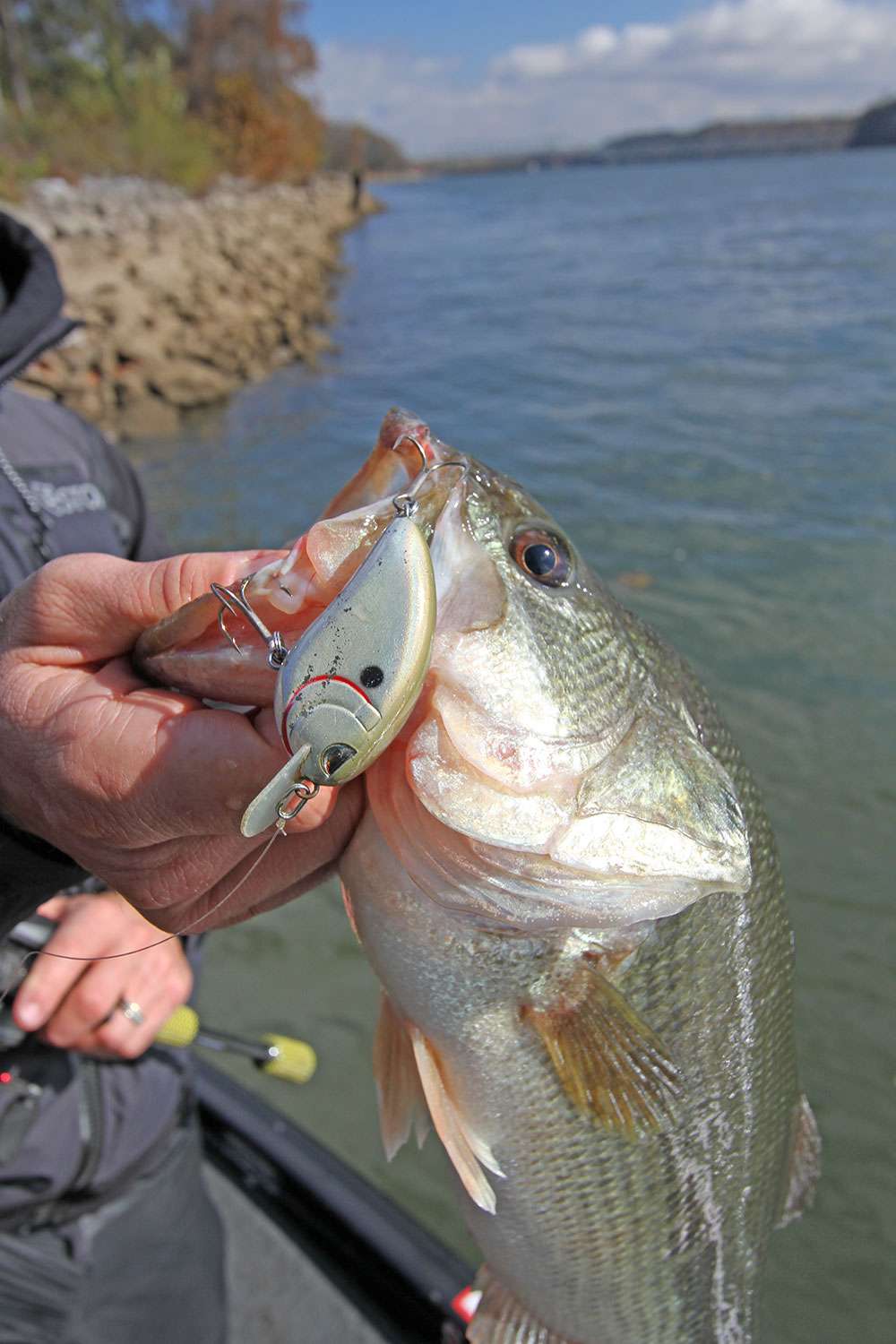
Yes, we’ve had a couple of cold fronts, but a relatively mild winter can bolster a seasonal tactic of which Elite Series pro John Crews was already a believer — cranking. Normal winter patterns see occasional warming trends that stimulate the fish, but with the past few winters bringing less of the harsh stuff — at least in the southern U.S. — Crews has enjoyed a pretty stout crankbait bite.
“If the water temperature is right in the wintertime, a crankbait can be golden,” the Virginia pro said. “In most parts of the country, fall is the time that fish key in on baitfish. In winter, those baitfish start dying off, so I think the fish start looking for that vibration (common to) a baitfish.”
As Crews notes, the dividing line is somewhere in the mid 40s. When water temps drop below that mark, the crankbait bite vanishes. When it’s 47, 48 or better, he has winding on his mind.

Sunny days help the overall picture, as bass will rise in the water column or move shallow to warm their backs. Doing so, he said, means a more active and more catchable fish.
Crews also appreciates the masking effect of stained water, but he’s always thankful for a little rustle in the trees.
“Wind blowing against any structure can help because it creates turbulence and bass have a harder time seeing what’s going by them,” he said. “They have a harder time identifying what they’re looking at because they don’t get a good look at it. The only way for them to try it out is to bite it.”

Where to wind
Arming himself with a 7-foot medium-heavy Cashion cranking rod and a 6.4:1 reel with 10-pound Sun Line Sniper fluorocarbon, Crews identified a trio of winter targets.
Riprap — Probably the most consistently availing habitat, those chunky rocks used to fortify bridge causeways, marina break walls and shorelines will hold fish throughout winter and into early spring. Usually not too far from deep water, riprap serves as a space heater that that also offers dandy feeding opportunities.
“As the days gets sunny, the fish will pull up on those rocks, sun themselves and hang out,” he said. “It’s a convenient spot for a fish looking for something to eat. Easy to slide off into deep water overnight.”
Crews fishes the riprap with a Spro Little John and sticks with the more bland shad colors like Cell Mate.
Focusing on the areas with greatest sun exposure, he’ll parallel the rocks to keep his bait close to the structure.
“I’ll reel down to hit the rocks a couple of times and then stop it,” he said. “That bait’s going to slowly float up. You can hesitate and it will stay in the strike zone, and then you can resume cranking where it will bounce back into the rocks. You can start and stop it very effectively on these spots.”

Transitional banks — Whether it’s boulders to chunk rock, chunk rock to pea gravel or any other scenario, Crews notes that changes in bank composition appeal to a bass’ inherent affinity to variances. Anything different represents potential ambush spots, but there’s also a proximity point.
“A lot of times, transitional banks are associated with depth changes; you might go from a flatter bank to a steeper bank,” he said. “If the terrain changes, there’s usually a reason those types of rock change. It’s usually a depth change and that adds to the allure of that area.”
Crews sticks with the Spro Little John, but his color choice may vary. The shad colors work for most of winter, but as we move closer to the prespawn, he’ll switch to crawfish patterns like Spring Craw or in southern lakes, he’ll use Western Craw.
“As spring approaches, the fish definitely start to respond better to the reds and oranges,” Crews said. “Crawfish hibernate in winter and they come out of hibernation when the water reaches the 50s.
“The bass don’t have a temperature gauge, but when the water warms, they know the crawfish will come out of their holes.”
Similar to the riprap approach, Crews makes long casts parallel to the bank and uses a start-and-stop cadence to offer fish little windows of opportunity to get the bait on a pause.
Channel swing banks — Calling these the “pathways” for fish moving in and out of creeks, Crews expects to find fish staging on these deeper banks en route to their next move — particularly prespawn transitions. The fish may or may not be feeding, but these rest stops offer the comfort of deeper water and the ability to pin prey against a typically vertical bank.
“Most of the times, those channel swing banks are on the south side, so they’re not in the sun,” Crews said. “You get a shading factor, but that doesn’t matter because, even if a bank is shady all day long, they will still be on it in the prespawn.”
As Crews points out, the fish are more concerned about their seasonal movement than sky conditions. On the flipside, he’s fine with fishing a channel swing bank with no wind because the dimness of shaded water obscures his bait.
“I’ll use a Spro Little John MD on the channel swing banks because it gets down a little deeper,” he said. “A lot of times you’ll run into submerged laydowns and that bait comes through wood really well.
“If I can find a laydown or brush, I’ll leave that crankbait sitting there because it slowly floats up. That helps trigger more bites.”
Colors mimic those of the transitional banks, as does casting style. Good thing, Crews said, is that once you find fish on channel swing banks, that’s a replicable pattern you can run creek-to-creek.
Originally published in 2017.






